Hi All,
Today, we’ll take a first look at New Hotness like Null Time Zone, Spheres of Solitude, Behavior Modification Device, and Avengers Assemble! We’ll also revisit such Cerebro regulars as Reign of Terror, Latverian Embassy, Lazarus Pit, and Ra’s Al Ghul, The Demon’s Head.
As always, we’ll kick off with the feature question, which is actually a pair of feature questions that are both equally thought provoking. Without further ado:
Let’s say I have an Armies of Qward and Orinda face up in my resource row. Let’s also say I control an army Manhunter character (like Manhunter Sniper), and recruit a non-Manhunter army character (like Robot Destroyer). Will I be able to move Robot Destroyer to my hidden area with Orinda’s effect?
Tim Z., Ames, IA
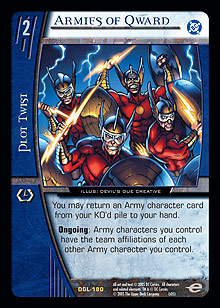 Yep. The key here is that when a character comes into play, continuous modifiers (like Armies of Qward’s) get “updated” before any comes-into-play triggers (like Orinda’s) fire. So, by the time Orinda’s power asks whether an army Manhunter character has come into play under your control, Armies of Qward’s modifier has made the answer affirmative.
Yep. The key here is that when a character comes into play, continuous modifiers (like Armies of Qward’s) get “updated” before any comes-into-play triggers (like Orinda’s) fire. So, by the time Orinda’s power asks whether an army Manhunter character has come into play under your control, Armies of Qward’s modifier has made the answer affirmative.
My opponent announces that he is recruiting Ra’s Al Ghul, The Demon’s Head. I control only Marvel Knights characters and a face-down Midnight Sons. I believe I can flip Midnight Sons (naming LOA, obviously) to protect my MK characters before RAG’s modifier comes into effect. Am I right? How late can I do this before I miss out and my characters lose their team affiliations?
Tim Z., Ames, IA
Yep, you can play Midnight Sons while the recruit effect is on the chain, but not after it has resolved (since you will then no longer control any MK characters).
Assuming you play it in response to the recruit effect, two continuous modifiers interact after Ra’s comes into play. Each depends on the other.* For each object affected by such a dependency loop, we first need to apply the earliest modifier in the loop applicable to that object.
The Midnight Sons modifier is applicable to every character you control (because you control only MK characters) and has an earlier timestamp than the Ra’s modifier. So, for each character you control, Midnight Sons applies first (giving that character the LOA affiliation), then Ra’s second, failing to make that character unaffiliated because Midnight Sons has already given it the LOA affiliation.
The end result is that Midnight Sons makes each of your characters dual-affiliated before Ra’s can make any unaffiliated.
My question is about your recent writing contest. I need a clarification on how Spirits of Vengeance works. Does SOV have a triggered power? Or can it be used any time during the attack? Mainly I ask to check if you could power up an attacker and then use SOV’s effect.
Bryan M.
SOV’s effect is triggered, but you can still do the trick you’re suggesting.
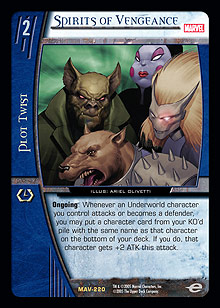 Spirits of Vengeance triggers whenever an Underworld character you control attacks or becomes a defender. While that triggered effect is still on the chain, you can discard a card to power up that character. Then, when SOV’s triggered effect resolves, you can put the discarded card on the bottom of your deck. After both effects resolve, that character gets a total of +3 ATK and +1 DEF this attack.
Spirits of Vengeance triggers whenever an Underworld character you control attacks or becomes a defender. While that triggered effect is still on the chain, you can discard a card to power up that character. Then, when SOV’s triggered effect resolves, you can put the discarded card on the bottom of your deck. After both effects resolve, that character gets a total of +3 ATK and +1 DEF this attack.
I was reading the final match coverage of the recently concluded Melbourne $10K event and I noticed that Alex Brown flipped Behavior Modification Device with only Squadron Supreme characters in play. Is this legal?
Brian E., Cebu, Philippines
Would it be possible to run Behavior Modification Device in a mono-Squadron deck? I can’t get a definitive answer.
Justin A.
Absolutely. It doesn’t say to “play only if there are two or more different affiliations among characters you control,” or to “choose two different affiliations as an additional cost,” or anything like that, so you can indeed play it in a mono-Squadron deck.
If you do, the “choose affiliations” effect will resolve and do nothing (because you can only choose one at most), causing the ongoing “team-up power” to do nothing also. However, the ongoing payment power will work just fine.
(By the way, Mad Propz ™ to Metagame.com’s tech Svengali for his fifth Top 8 and fourth appearance in a $10K final match!)
My friends and I were recently play testing, and one of us dropped Foxfire against a Golden Age team-up deck. I was wondering if anything has been done about her power with respect to Golden Age team-up cards. If not, she could be a huge boost to the Squadron against any pre-Avengers team-up strategies.
Joe R., Pasadena, CA
Since team-up cards are explicitly defined as cards with the team-up version, Foxfire can potentially replace older plot twists and locations like Common Enemy and Metropolis because they don’t have that version.
I control Doomsday and attack my opponent’s character. Both characters become stunned during attack conclusion, and Doomsday’s power triggers. If I play Panacea Potion to recover Doomsday in response to his triggered effect, will Doomsday ready after he recovers?
Dennis C., Manila, Philippines
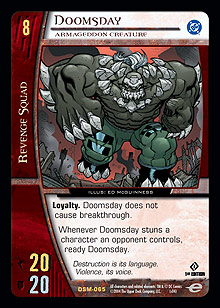 Sure. Doomsday’s triggered effect tries to ready him when it resolves. If he is stunned at that time, then it resolves but does nothing. However, if he has been recovered by Panacea Potion before his triggered effect resolves, it will successfully ready him.
Sure. Doomsday’s triggered effect tries to ready him when it resolves. If he is stunned at that time, then it resolves but does nothing. However, if he has been recovered by Panacea Potion before his triggered effect resolves, it will successfully ready him.
I have a couple of questions regarding Kang Council and League of Assassins, since these two teams have the ability to remove team affiliations and recover their own characters. Let’s say my opponent controls a stunned Bane, Ubu and I control a ready Kang, Earth Mesozoic-24. My opponent attacks Kang with another character, and I exhaust Kang to play Finishing Move targeting Bane. In response, my opponent flips Lazarus Pit and activates it targeting Bane, and I respond with Spheres of Solitude. Assuming my opponent decides against KO’ing Lazarus Pit to recover Bane,
1) Is it legal to target the stunned Bane with Spheres of Solitude?
Well, Spheres of Solitude doesn’t target, but yes, you can choose Bane on resolution, even if he is stunned.
2) Would that mean Lazarus Pit’s activated effect resolves without being able to prevent Bane’s KO?
Dennis C., Manila, Philippines
Actually, that effect is negated because Bane is no longer a “stunned LOA character” on resolution, so all of its targets are illegal.
I control a stunned character named Kang and recruit another character named Kang. Is the stunned Kang unique since he has no text? Do I have to KO him?
John H., Tulsa, Oklahoma
A friend of mine brought this to the attention of everyone at the card store where we play. All of the Kangs say, “Kang is not unique,” but there’s a rule that says, “If a modifier refers to the name of the card that produced it, it is only referring to the card whose text produced the modifier, and not any other instance of that card.” That means that each Kang is not unique only to itself and itself alone. If any other Kang is played, all others will be KO’d. It’s obvious that this was not UDE’s intention, but the way the card is worded, Kangs are all effectively unique. If Kang read, “Characters named Kang are not unique,” then there would be no problem.
Ethan S., Florence, MA
Well, the good news is that there is no problem. The rule at the center of both questions is, “As part of resolving a recruit effect for a card with the unique characteristic, its controller-to-be must check the names of all objects he controls that are already in play. He puts all of those with the same name as that unique recruited card into his KO’d pile.”
So essentially, it only matters whether the Kang currently being recruited is non-unique (which it always is). As long as that Kang is non-unique, none of the other Kangs you control will be put into the KO’d pile as part of resolving that Kang’s recruit effect (regardless of whether or not the other Kangs you control are unique).
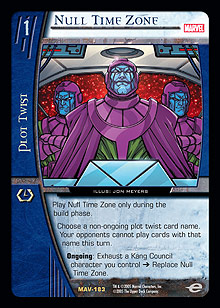 Null Time Zone is generally taken to mean that you must choose the name of a plot twist card. But surely, Bastion is a “non-ongoing plot twist card,” so shouldn’t it be possible for me to name him? (Or Dr. Doom, or Dr. Light, or Sinestro, or any of a number of annoying characters.) Is there a reason it’s not?
Null Time Zone is generally taken to mean that you must choose the name of a plot twist card. But surely, Bastion is a “non-ongoing plot twist card,” so shouldn’t it be possible for me to name him? (Or Dr. Doom, or Dr. Light, or Sinestro, or any of a number of annoying characters.) Is there a reason it’s not?
Felix H., Lenton, UK
Yup, the hyphen means that the “non-” applies only to the “-ongoing”. So, asks you to name a plot twist that is not ongoing, rather than a card that is not an ongoing plot twist. Mathematically:
(non-ongoing) plot twist
rather than
non-(ongoing plot twist)
The following question came up in a discussion on an online forum. The short question is, when is a character considered recruited? The long question is, suppose my opponent plays Dr. Doom, Diabolic Genius and I respond by playing Null Time Zone before the recruit effect resolves. Before I name a card, I pass priority to him. Can he play Reign of Terror at this point? My argument is no, because a character card on the chain is not yet a recruited character.
Orry S., Singapore; and Chris K., Australia; and Kingzter, Philippines
Your opponent can indeed play Reign of Terror at that point, because “recruited” has a very particular definition. According to that definition, your opponent recruited Dr. Doom as soon as he successfully added Dr. Doom’s recruit effect to the chain.
What is the proper way of playing Latverian Embassy? An opponent flipped Latverian Embassy in response to my playing a second Teen Titans Go! He thought that because TTG can’t be played, it would be turned back down. Is he correct? I found this weird, since TTG was already played and on the chain.
Philip H., Manila, Philippines
You’re totally correct. Latverian Embassy does not “rewind” already-played plot twists, nor does it negate any plot twist effects already on the chain.
If you have priority to play the second TTG, then your opponent is too late to flip Latverian Embassy to stop you. He has to flip it before you get priority.
I just need a quick clarification on why an opponent can’t reinforce in response to Justice, Like Lightning. I was playing a game against a guy at my local store who insisted that he could. I think I’m right (mostly because I read it in a Chris Fletcher article), but I need to give him a good reason why.
Tom
Unfortunately, this is wrong. You can certainly reinforce in response to Justice, Like Lightning. The trick to the card is that you don’t choose the character to exhaust until resolution, so if your opponent does reinforce in response, you get to exhaust another character he controls (so he ends up with two exhausted characters). But no, nothing stops him from reinforcing in response.
If I play Avengers Assemble! twice in one turn to search for the same character card, does that character come into play with two +1/+1 counters on it? If it does, then assembling for an army character is really good!
Stanley C., Flushing, NY, USA
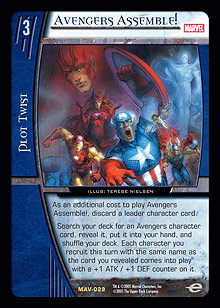 It does and it is! Each Avengers Assemble! creates a modifier on resolution, and each modifier puts a +1 ATK/+1 DEF counter on each appropriately named character you recruit this turn.
It does and it is! Each Avengers Assemble! creates a modifier on resolution, and each modifier puts a +1 ATK/+1 DEF counter on each appropriately named character you recruit this turn.
It’s time again to bring down the curtain on another column, but at least this time I can leave you with alluring visions of army swarms weighed down with counters from Avengers Assemble! Please keep your questions coming in to vsrules@gmail.com.
* How do you determine that they depend on each other? By asking two questions:
1) Can the Midnight Sons modifier change what objects the Ra’s modifier could apply to? Yes, it can change a non-LOA character into an LOA character. So the Ra’s modifier depends on the Midnight Sons modifier.
2) Can the Ra’s modifier change what objects the Midnight Sons modifier could apply to? Yes, it can change an MK character into an unaffiliated character. So the Midnight Sons modifier depends on the Ra’s modifier.